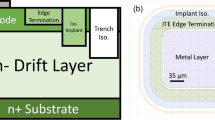Abstract
The effects of microvoid defects on the performance of mid-wavelength infrared (MWIR) HgCdTe-based diodes were examined. Molecular beam epitaxy (MBE) was utilized to deposit indium-doped, Hg0.68Cd0.32Te on 2 cm × 3 cm, (211)B-oriented, bulk Cd0.96Zn0.04Te substrates. These epilayers generally exhibited state-of-the-art material properties with a notable exception: high and nonuniform microvoid defect densities (mid 104 cm−2 to low 106 cm−2). Diodes were fabricated by ion implantation of arsenic to form planar p–n junctions. Dark current–voltage (I–V) curves were measured and analyzed as a function of operating temperature. There was an inverse correlation between wafer-level microvoid defect density and device operability. On each wafer, devices with the smallest implants exhibited higher operability than devices with larger implants. By removal of pad metal and examination of defects within each implant area, it was found that the presence of one or more microvoids within the junction usually caused tunneling or other high-current mechanisms. Diodes free from microvoids exhibited diffusion-limited behavior down to 150 K, the test set limit.
Similar content being viewed by others
References
E. Selvig, C.R. Tonheim, T. Lorentzen, K.O. Kongshaug, T. Skauli, and R. Haakenaasen, J. Electron. Mater. 37, 1444 (2008).
E. Selvig, C.R. Tonheim, K.O. Kongshaug, T. Skauli, T. Lorentzen, and R. Haakenaasen, J. Vac. Sci. Technol. B 25, 1776 (2007).
E.C. Piquette, M. Zandian, D.D. Edwall, and J.M. Arias, J. Electron. Mater. 30, 627 (2001).
F. Aqariden, H.D. Shih, A.M. Turner, and P.K. Liao, J. Electron. Mater. 30, 794 (2001).
D. Chandra, F. Aqariden, J. Frazier, S. Gutzler, T. Orent, and H.D. Shih, J. Electron. Mater. 29, 887 (2000).
J.B. Varesi, A.A. Buell, J.M. Peterson, R.E. Bornfreund, M.F. Vilela, W.A. Radford, and S.M. Johnson, J. Electron. Mater. 32, 661 (2003).
P.S. Wijewarnasuriya, M. Zandian, D.B. Young, J. Waldrop, D.D. Edwall, W.V. McLevige, D. Lee, J. Arias, and A.I. D’Souza, J. Electron. Mater. 28, 649 (1999).
J.M. Arias, M. Zandian, J. Bajaj, J.G. Pasko, L.O. Bubulac, S.H. Shin, and R.E. DeWames, J. Electron. Mater. 24, 521 (1995).
Author information
Authors and Affiliations
Corresponding author
Rights and permissions
About this article
Cite this article
Billman, C.A., Almeida, L.A., Smith, P. et al. The Effects of Microvoid Defects on MWIR HgCdTe-Based Diodes. J. Electron. Mater. 40, 1693–1698 (2011). https://doi.org/10.1007/s11664-011-1658-1
Received:
Accepted:
Published:
Issue Date:
DOI: https://doi.org/10.1007/s11664-011-1658-1




